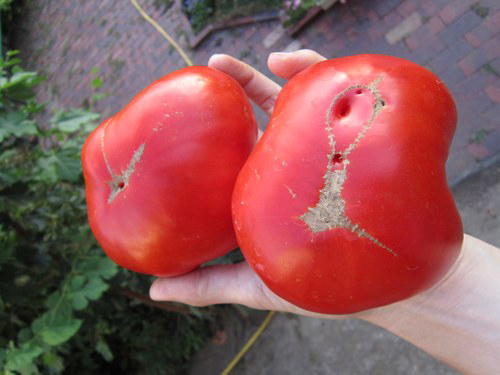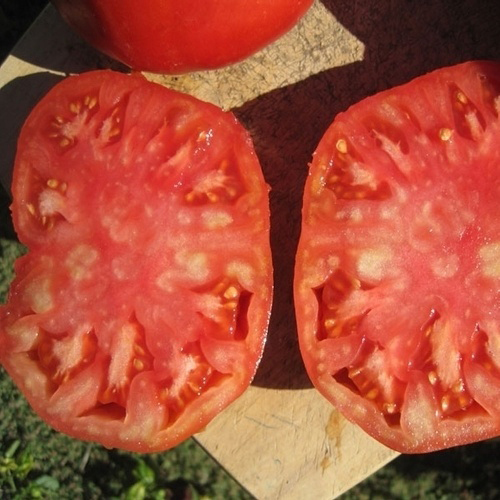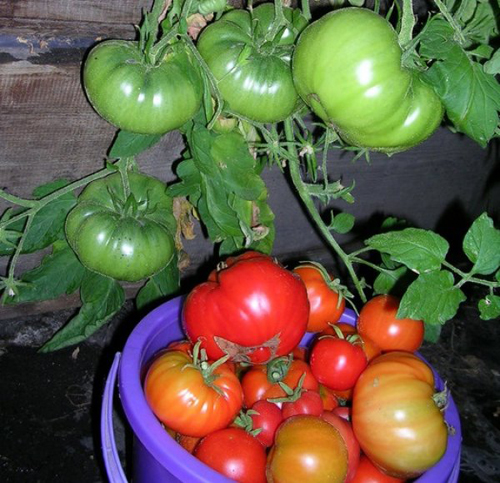Tomato variety Bear's paw
Is it possible to grow weighty fruits on a low tomato bush? Of course, yes, if you plant a variety called Bear's Paw. It belongs to the selection of V.N. Dederko, who in 2003 filed an application for registration of a novelty. In 2005, the tomato was included in the State Register of Breeding Achievements of the Russian Federation with admission in all regions. Designed for growing in open ground garden plots, home gardens and small farms. But in cooler regions it can be successfully grown in greenhouses.

Interestingly, when purchasing seeds from various seed companies, you may be surprised to find that the description of the plant does not always coincide, as does the result when growing. Therefore, talking about the appearance and characteristics of the Bear's paw, we will rely on the State Register and compare this information with that obtained from other sources.
Description of the variety
The plant belongs to determinant, but this does not mean at all that the tomato will limit itself in growth on its own. Thus, a bush in the open field can reach a height of 1.7 meters, and in a greenhouse even 2 meters. Shoot-forming ability is moderate, foliage is good. Leaves of the usual type, large, dark green, slightly wrinkled. The inflorescences are simple. The first fruit cluster is laid over the 9th leaf, the subsequent ones are formed through 1 or 2 leaves. On the main stem of the Bear's paw, from 3 to 5 brushes are formed, bearing 4 to 5 ovaries.

The fruits of this variety look spectacular - they are flat-round, moderately dense, rather large - weighing from 115 to 300 grams (sometimes all 500 grams), in this description the State Register is not stingy. Other sources boldly promise 800-gram copies. The skin is not thick, glossy. An unripe tomato is colored green; near the stalk there is a varietal dark green spot. Ripe tomato turns red, which is confirmed by numerous reviews. Although some gardeners describe the color as pink. The pulp is very fleshy, low-liquid, sugary at the break, moderately dense, with a high dry matter content. The number of seed nests is 3 - 4. The taste of fresh fruits is excellent.
Variety characteristics
- Bear's paw is a mid-season tomato. From the moment of emergence of full shoots to the beginning of ripening, 110 to 115 days pass. However, depending on weather conditions, ripening may be delayed by a week;
- the yield is good - from one square meter it is 7.1 kg (according to the State Register). "Siberian Garden" promises up to 6 - 8 kg per plant. On the forums, gardeners call yields average or above average;

- the harvesting period lasts from July to September;
- the yield of marketable fruits in the Altai Territory is quite high - 93, 9%;
- resistance to major diseases of the culture is high, for example, due to early maturity, it is possible to avoid massive damage by late blight. In addition, the species is resistant to tobacco mosaic;
- the declared drought resistance of tomato is indeed confirmed by gardeners who have tested this characteristic in practice;
- the variety is quite heat-resistant, so in the southern regions there is no need to fear for the weak formation of inflorescences during the heat;
- with moderate soil moisture, the peel of the fruit of the Bear's paw does not crack, but if this factor is neglected during the period of maturity and the garden bed is greatly moistened, then large-fruited tomatoes can burst near the stalk;
- opinions differ regarding a sharp cold snap, in some cases it is argued that the plant is quite resistant to such unfavorable conditions, in others, on the contrary, it is said that the bush can shed inflorescences;
- if the summer is cold or there is a lack of trace elements (potassium) in the diet, a green center may remain in the pulp;
- transportability and keeping quality of fruits are low, but quite sufficient for amateur cultivation or small business. The shelf life can be increased by removing the tomatoes at the stage of blanche ripeness;
- the way of eating fruits is universal. Of course, large-fruited tomatoes are not suitable for whole-fruit canning, but they produce good quality tomato products - pasta, juice, sauces. And, of course, the variety is primarily intended for salad use.
Agrotechnics
The Bear Paw is grown using seedlings. Seeds are sown 60 - 65 days before the intended transplantation. The sowing time of seed is best calculated independently, taking into account climatic features. The seeds are buried no more than 2 cm, before sowing, standard processing and stimulation are carried out. In open ground, dived and hardened seedlings are planted as soon as the threat of recurrent frosts has passed. The planting pattern is usual - 40 cm between bushes in a row, 50 cm - row spacing. The recommended density per square meter is about 3 plants.
The bush is subject to mandatory formation - as a rule, 1 or 2 stems are left on it, so that the yield is pleasing and the large-fruited does not suffer. There is information that the variety is formed in 3 - 4 stems, but in this case the weight of the tomato will be far from ideal. The bush of the Bear's paw is tied to a support, the brushes can also be tied up during the ripening period so that no creases are formed. The care is standard for the culture as a whole. Top dressing is required, they must have a balanced composition. Watering is not necessary frequent, but sufficient. In central Russia, subject to precipitation, plants are watered about 3 times during the growing season. Treatment for diseases and pests will not be superfluous, which should be carried out strictly according to the instructions attached to the drug.
The bear's paw will delight you with a good large-fruited harvest. Excellent heat resistance and drought resistance of the variety will save the gardener from the extra hassle of shading tomato bushes and worries about the missed watering period. In addition, seeds harvested on their own will surely give a crop next year that corresponds to all varietal characteristics.








